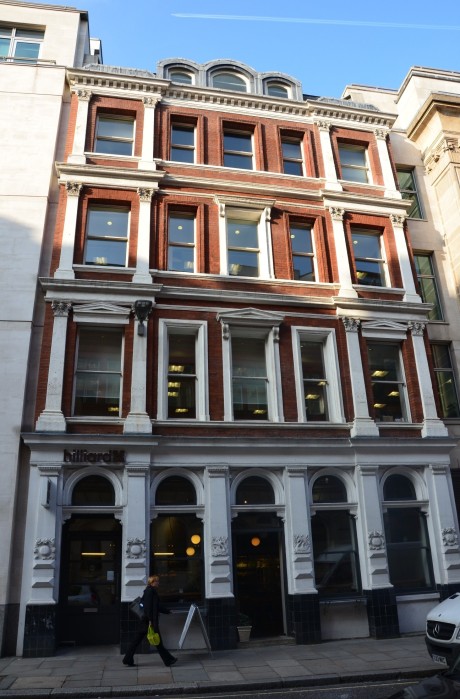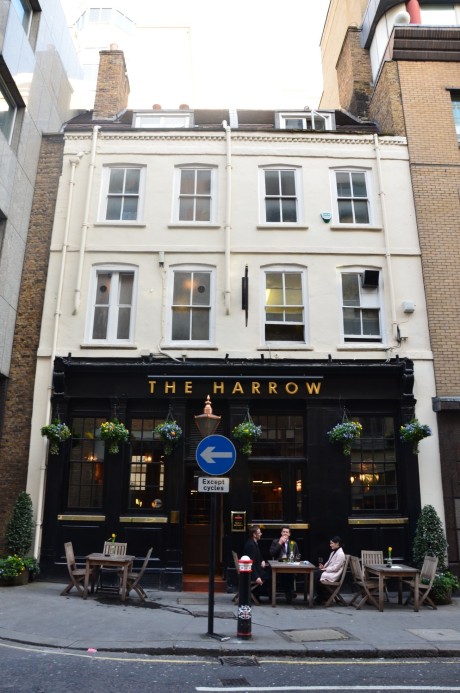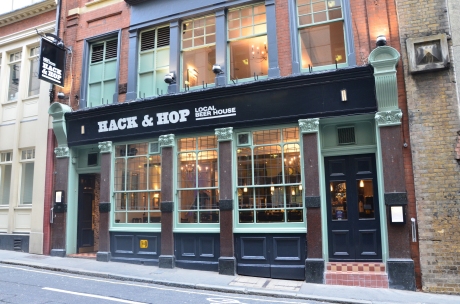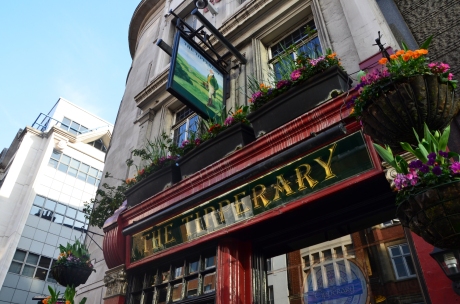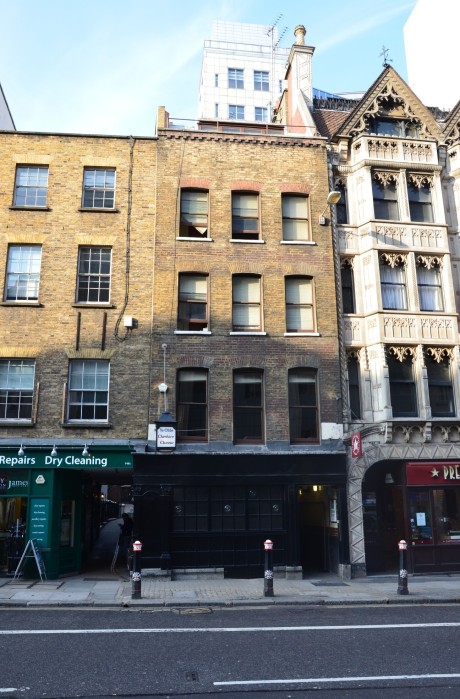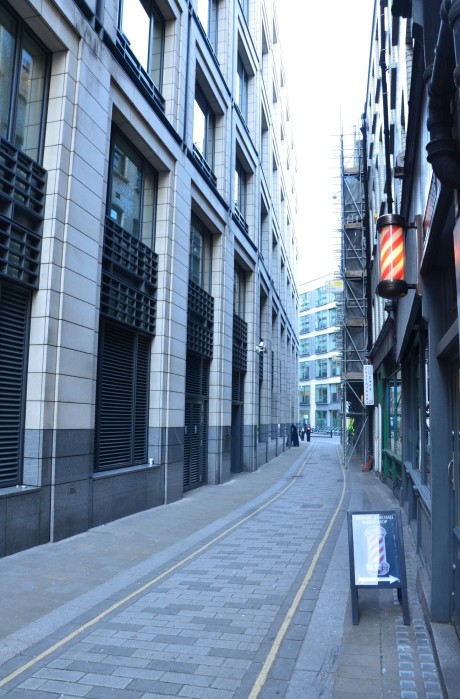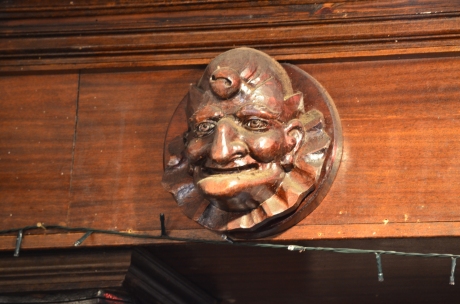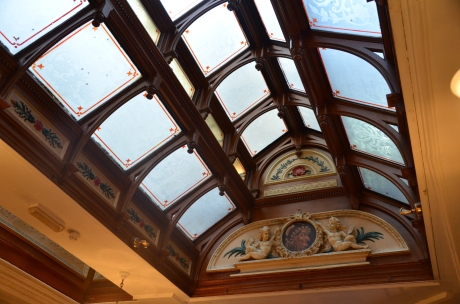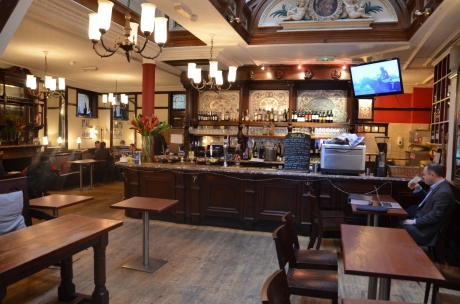City of London Pubs (1973): Forty Years On
March 13, 2014
City of London Pubs: A Practical and Historical Guide was published in 1973. A charming gazetteer written by Timothy M. Richards (“a public-house manager with a keen interest in the history of pubs”) and James Stevens Curl (“an architect with ‘a great interest in pubs, taverns, inns and drink’”), the content is both historically thorough and winningly casual as the two men catalogue the pubs of the City, which, as the cover states, “has, in fact, a higher density of pubs than any other comparable area in England, Scotland or Wales.”
Throughout the book, the two gently hammer home that the only way to truly enjoy the City pubs – while they may be beautiful, architecturally impressive or historically important – is to drink in them. This mission statement is launched with a quote from GK Chesteron’s A Ballade of an Anti-Puritan:
Is it not true to say I frowned,
Or ran about the room and roared;
I might have simply sat and snored –
I rose politely in the club,
And said “I feel a little bored;
Will someone take me to a pub?”
“Follow us!” Richards and Curl reply.
The book “takes the form of several pub crawls which even the most dedicated imbiber would need days to complete.” Richards and Curl split the City pubs into ten areas, “each area including a manageable number of pubs.” A manageable pub-crawl was clearly a more serious undertaking in 1971: the shortest crawl the book suggests is fourteen stops, the longest 23.
Perhaps this explains why their acknowledgements at the end of the book thank the person who typed their manuscript “from a less than tidy original”, and the police “for their good humour.”
When I first picked up the book and got stuck into it, it was a surprise to realise it was written 43 years ago. It certainly doesn’t read that way. In fact, I can’t think of a better book about the City’s pubs – or any guide to pubs, for that matter – than this one.
“Many books have been published concerning the City churches and the famous public buildings and even one dealing with the loos,” the authors write in the foreword. “But there is no comprehensive guide…After all, there are about 200 drinking establishments in the City, including wine bars, and these are well worth a study in themselves. Many older books, while devoting whole chapters to the City, are unfortunately out of date, or too clumsy.”
But while it isn’t ever clumsy, City of London Pubs has sadly joined those out-of-date books. The authors were only too aware of this inevitable fate – in the introduction, they clearly state “the information in this book is correct at the end of December 1971. As far as possible subsequent changes have been incorporated, but these cannot be guaranteed.” Their appendix demonstrated just how quickly things changed: it lists four pubs featured in the main body of the book, which had been demolished by the time of publication.
Thankfully, some of the gloomy apprehensions they raised about the future of pubs in the City have not been realised.
The seemingly unstoppable rise of the City wine bar was a twenty-year fad, and today many of these invaders have been supplanted in turn by branches of Itsu, Pret A Manger and vast corporate headquarters.
Richards and Curl lamented that “the traditional inn signs are fast giving way to neon atrocities”, but this too turned out to be a passing craze.
They also complained of a new ill: inexperienced barmaids, used only to pouring lager through a tap, who refused to pour natural beers into glasses and instead expected customers to come round the bar to do it themselves. They feared the solution to this problem would be pubs “refusing to stock the last few real beers containing sediment in the bottle. Despite a touch-and-go period in the 1980s when lager looked like it would batter bitter into submission, the demise of real ale never came to pass –today, you can probably get more varieties of natural beer in London that at any other point in its history.
In March 2014, I set out to walk in the footsteps of City of London Pubs, to see what changes have happened in the forty-three years since it was published. In an exact reverse of Richards and Curl’s work, I’ve kept my written notes to a minimum but have included photos of each pub (or if its been demolished, whatever’s replaced it.)
The main change I noticed, apart from the demolition of a number of pubs, is the total abscence of separate bars – the public bar, the saloon bar – some of which the book mentions were still in situ in the 1970s but all of which have since been removed.
Should you happen to have a copy to hand, this entry covers Richards and Curl’s first and fourth areas, which covers the ground from Fleet Street to Southwark Bridge (despite the numbering, Areas 1 and 4 border each other.) The numbering of the pubs is the same as it appears in the book.
AREA 1
No. 1 – YE OLDE COCK TAVERN, 22 Fleet Street, EC4
Like many pubs in the City, Ye Old Cock Tavern boasts a connection with Pepys (who visited in April 1668 with the actress Mrs Knipp, where he “drank, ate a lobster, and sang, and mighty merry”), but the present building is a relatively recent home dating from the mid-1880s. Previously, The Cock was situated in Apollo Court, on the opposite side of Fleet Street – the opening of a new branch of the Bank of England forced the move.
The dark, rather cavernous pub remains much as described in the book.
No. 2 – THE CLACHAN, Old Mitre Court, Fleet Street, EC2
A modern pub “with a small upstairs bar and a large dive bar and restaurant” built close to the site of the ancient Mitre Inn (Dr Johnson’s ‘place of frequent resort’), this has disappeared since the book was written – indeed, the lack of a specific address in the tiny square makes it hard to tell where it originally was. The only thing which remains is the Bishop’s Mitre above the door of a spectacularly boring looking office opposite.
No.3 – EL VINO’S, 47 Fleet Street, EC4.
One of the most famous of London’s drinking establishments, “the suitably sombre and discreet” El Vino’s is still going strong.
No. 4 – THE WELSH HARP, 3 Temple Lane, EC4
Back in 1971, the Welsh Harp was “a large pub of four storeys, the ground floor having an arcaded treatment of late Victorian date. Above, the stock-brick facade has rubbed red-brick arches over the windows, and there is a plain crowing cornice.” In 2014, there is absolutely no trace left of the pub but the “arcaded” ground floor can still be seen.
Bar the ancient looking stone bumper on its corner (which is clearly still protecting the building from the side-swiping construction lorries constantly winding through these narrow roads), the building in its place felt so uninspiring, I forgot to even see what it was.
No. 5 – THE WHITE SWAN, 28-30 Tudor Street, EC4
In 1971, the White Swan, with its interior “in mid-1930s style”, was “a good homely local, known to everyone as The Mucky Duck.”
In 2014, it has gone – in its place is a sandwich / salad bar with the not particularly sandwichy-salady-bar-name of ‘Hilliard’. On each side of the door remain two stone white swans, the only reminder of the building’s former life.
Since the 1970s, even the road layout has changed. Where the White Swan was once the corner building on Tudor Street, Tudor Street no longer exists – its former route is now covered by the vast monolithic offices of an international global law firm.
No. 6 – THE HARROW, 22 Whitefriars Street, EC4
While the divided bars that were present in 1971 have been removed and numerous internal refits have been performed over the years, the Harrow is still serving. Unusually, it has entrances on both sides of the pub – front and back.
No. 7 – THE COACH AND HORSES, 35 Whitefriars Street, EC4
A pub with an original late Victorian facade, it had been modernised by 1971 so that “the charming front is all that remains.” Today, the pub – or as the front has it, “local beer house” – has changed its name from The Coach and Horses to The Hack and Hop, presumably a late nod to the area’s journalistic history. Having walked the whole of the area, this is the only contemporary-looking pub-restaurant I came across.
No. 8 – THE TIPPERARY, 66 Fleet Street, EC4
Proclaiming itself “London’s oldest Irish pub”, the pub was opened on the site shortly after 1883 (although the name The Tipperary is more modern.) In 1971, it was “a long, narrow pub in traditional Irish urban style, with rich, dark panelled walls; engraved green glass panels with gilt lettering advertising whiskey and stout; carved display stands; mirrors; and resplendent lamps.” It’s largely the same four decades later.
No. 9 – THE FALSTAFF BAR, 67 Fleet Street, EC4
A “small, narrow bar in the basement of a restaurant” which was all that remained of a “once much larger house called The Falstaff, which closed in 1971”, there was absolutely nothing to signify any bar had ever existed on the site in 2014.
No. 10 – YE OLDE CHESHIRE CHEESE, Wine Office Court, 145 Fleet Street, EC4
One of the capital’s best known inns, it is probably the last pub in the City which will ever be changed. While the tourists enjoy the smoky fires and the faux-grubbiness inside, it’s worth taking a moment to admire the less remarked-upon exterior “with its sash windows, wooden panels, fanlight, and great hanging sign…an excellent example of the sort of pub front that existed in the eighteenth and nineteenth centuries.”
No. 11 – THE KING AND KEYS, 142 Fleet Street, EC4
Almost next door to the Cheshire Cheese, in 1971 the King and Keys could boast a ceiling which “lowered by means of large wooden square” and which “incorporates lights and two applicable motifs. One is a rose, crossed keys, and a knight’s head; the other an orb, crossed maces and a crown.” The pub closed in 2009, and the building is now a Mexican takeaway snack bar.
No. 12 – THE COGERS, 9 Salisbury Court, EC4
In 1937, the eighteenth-century inn (whose name came from the Ancient Society of Cogers, a debating group who made the pub their home) was reincorporated into a modern building built for Reuters by Sir Edwin Lutyens. In 1971, Richards and Curl reported that the Cogers was large and “very much of its period…subdivided spaces give it a pleasant atmosphere…the screens have opaque glass set in; leaded lights are provided, even in the doors; and the bar is panelled, with rails.”
Today, the pub has disappeared – in 2009, the redevelopment of the building saw it replaced with a Sir Terence Conran-designed restaurant called Lutyens. The restaurant is actually on the other side of the road from where I took this picture – when I saw the restaurant, part of the grand deco building, it didn’t strike me that a pub could ever have been there. It was only later I was able to place where it was – so until I go back, here’s the view that the Cogers used to look out on.
No. 13 – THE OLD BELL, 95 Fleet Street, EC4
Originally built in 1670 for Sir Christopher Wren’s workmen, who were rebuilding St Bride’s after the Great Fire of London in 1666, the pub has changed its name numerous times over the centuries. The glass window which Richards and Curl admired in 1971 is still present in 2014, and the pub itself is little changed.
No. 14 – THE RED LION, Poppins Court, EC4
In 1971, Richards and Curl admired the Red Lion, “a decent three-storey building…good panelled ceiling and mirrors contribute to the late Victorian atmosphere…the dark wood of exterior and interior, yellowed walls and old ceiling all bear witness to a distinct lack of youth.” They also noted that “above the alleyway’s entrance one can still see the original tavern sign with a popinjay (a corruption of which gave the court the name Poppins) or parrot carved in stone.”
In 2014, all this has been comprehensively wiped away. The gap between the buildings is still called Poppins Court, but it couldn’t look any less like a Court, or any more like a service road cowering in the shadows of the towering office block it serves.
No. 15 – THE PUNCH TAVERN, 99 Fleet Street, EC4
Largely unchanged since 1971, the Punch Tavern has some lovely brassy Victorian plasterwork and decor – the closest one comes to seeing a gin palace on this walk.
Carvings of Punch and Judy above the bar, paintings of Toby the Dog in the tiled mosaic entranceway, a great glass skylight, dark wood and mirrors everywhere…
…but as Richards and Curl pointed out 40 years ago, “originally the space would have been subdivided and much more intimate in character. It is far too open and almost intimidating now.” It may be too open, but it’s not intimidating – when I went in, the staff couldn’t have been nicer and the clientele consisted of a few businessmen and two women with babies eating lunch. That said, it’s hard to deny that the entrance is much more fun than the inside.
No. 16 – THE ALBION, 2-3 Bridge Street, EC4
Still open, the Albion is still “a popular lunchtime rendezvous for eating, set within an undistinguished late-Victorian building.” When I walked past, even though it was gone 3pm, it was still full of City workers stuffing sausage and mash into their mouths.
No. 17 – THE ST BRIDE’S TAVERN, Bridewell Place, EC4
Up past a huge Premier Inn – the largest one I’ve ever seen, it looked like a terrifying battleship – is St Bride’s Tavern. In 1971, the authors of City of London Pubs said it was the type of comfortable pub which could become anyone’s local – but it’s a rather severe building which today hides a fairly unremarkable interior. It was the only pub I passed in the entire walk which was empty when I looked in. Good for the rest.
THE TALLY SO FAR:
Pubs covered in 1973’s City of London Pubs still open: 10 (1 renamed)
Pubs covered in 1973’s City of London Pubs now closed: 7
NEXT UP: AREA 4!






